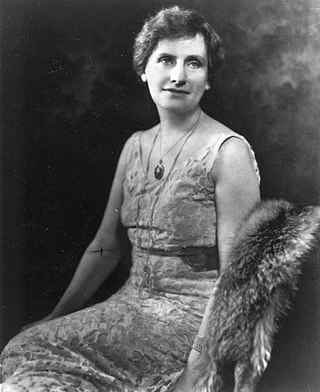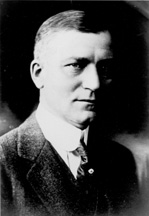
Nellie Davis Ross was an American educator and politician who served as the 14th governor of Wyoming from 1925 to 1927, and as the 28th and first female director of the United States Mint from 1933 to 1953. She was the first woman to serve as governor of a U.S. state, and remains the only woman to have served as governor of Wyoming. She was a Democrat and supported Prohibition. She ran for re-election but refused to campaign herself.

Joseph Maull Carey was an American lawyer, rancher, judge, and politician, who was active in Wyoming local, state, and federal politics.

William Bradford Ross was an American politician who served as the 12th governor of Wyoming as a Democrat.

The 1924 United States Senate election in Wyoming took place on November 4, 1924. Incumbent Republican Senator Francis E. Warren ran for re-election to his sixth consecutive term in the Senate. He was challenged by Judge Robert Rose of the Eighth Judicial District of Wyoming, the Democratic nominee. The election took place on the same ballot as the presidential election, with Republican Calvin Coolidge winning Wyoming by a wide margin, and the special gubernatorial election, with Democratic Nellie Tayloe Ross similarly winning by a wide margin. Both Warren and Rose outperformed their party's presidential nominees, and Warren ultimately won re-election by a wide margin, albeit reduced from 1918. This would be Warren's last term in the Senate; he died on November 24, 1929, with a little more than a year remaining in his term. Republican Patrick Joseph Sullivan was appointed to replace him.

The 1990 Wyoming gubernatorial election took place on November 6, 1990. Incumbent Democratic Governor Mike Sullivan ran for re-election. In the general election, he faced Republican nominee Mary Mead, a businesswoman and the daughter of former U.S. Senator and Governor Clifford Hansen. Owing to Sullivan's personal popularity, he won re-election over Mead in a landslide, marking the fifth straight Democratic victory in Wyoming's gubernatorial races, a streak that has yet to be broken by either party.

The 1930 United States Senate election in Wyoming was held on November 4, 1930. Following the death of Republican Senator Francis E. Warren, former Casper Mayor Patrick J. Sullivan was appointed to replace him. Sullivan did not seek re-election, however. Following a contested Republican primary, former Governor Robert D. Carey emerged as the nominee, and faced Democrat Harry Schwartz, an attorney from Casper and a local school board member, in the general election. Despite the strong performance by Democrats nationwide in 1930, Carey defeated Schwartz by a wide margin.

The 1910 Wyoming gubernatorial election was held on November 8, 1910. Incumbent Republican Governor Bryant B. Brooks declined to seek re-election. The leading Republican candidates to succeed him were initially former U.S. Senator Joseph M. Carey and Attorney General William E. Mullen. However, shortly before the Republican convention, Carey announced he would instead run as an independent candidate. Shortly thereafter, Mullen was formally nominated by the Republican Party. A week later, at the Democratic convention, Carey was named as the Democratic nominee for Governor. In the general election matchup between Carey and Mullen, Carey won a sizable victory, winning every county in the state, a feat that no other Democratic nominee would accomplish until Dave Freudenthal in 2006.

The 1918 Wyoming gubernatorial election took place on November 5, 1918. Following the election of Governor John B. Kendrick to the U.S. Senate in 1916, Secretary of State Frank L. Houx served as acting Governor. He ran for re-election and faced a stiff challenge in the Democratic primary from attorney William B. Ross. After defeating Ross by a decisive margin, he faced Robert D. Carey, the Republican nominee and the son of former Democratic Governor Joseph M. Carey. However, despite Houx's past electoral success, he faced difficult headwinds as Democratic candidates did poorly across the country in 1918. He ended up losing re-election to Carey by a wide margin.

The 1922 Wyoming gubernatorial election took place on November 7, 1922. Incumbent Republican Governor Robert D. Carey ran for re-election, but was narrowly defeated for renomination by banker John W. Hay. In the Democratic primary, William B. Ross, a 1918 candidate for Governor and the former Laramie County Attorney, defeated former State Representative George Kindler and Frank McDowell. The contest between Ross and Hay was close, with Ross narrowly beating out Hay, 51% to 49%, with a margin of just 723 votes. However, Ross would not end up serving a full term as Governor; he died in October 1924 and was eventually succeeded by his wife, Nellie Tayloe Ross.

The 1926 Wyoming gubernatorial election took place on November 3, 1926. Incumbent Democratic Governor Nellie Tayloe Ross, first elected in the 1924 special election, ran for re-election to a second term. She was narrowly defeated by the Republican nominee, former State Engineer Frank Emerson.

A general election was held in the U.S. state of Wyoming on Tuesday, November 3, 1998. All of the state's executive officers—the Governor, Secretary of State, Auditor, Treasurer, and Superintendent of Public Instruction—were up for election.

A general election was held in the U.S. state of Wyoming on Tuesday, November 2, 1926. All of the state's executive officers—the Governor, Secretary of State, Auditor, Treasurer, and Superintendent of Public Instruction—were up for election. Republicans narrowly picked up the governorship and solidified their control on the other statewide offices, increasing their margin of victory in each race.

A general election was held in the U.S. state of Wyoming on Tuesday, November 4, 1930. All of the state's executive officers—the Governor, Secretary of State, Auditor, Treasurer, and Superintendent of Public Instruction—were up for election. Republicans narrowly held onto the Governor's office and won every other state office.

A general election was held in the U.S. state of Wyoming on Tuesday, November 7, 1950. All of the state's executive officers—the governor, secretary of state, auditor, treasurer, and superintendent of public instruction—were up for election. The Republican Party swept all of the offices. Following Democratic governor Lester C. Hunt's election to the U.S. Senate in 1948, Republican secretary of state Arthur G. Crane had been acting as governor. Republican Congressman Frank A. Barrett was elected governor, and Republican candidates won the other statewide races.

A general election was held in the U.S. state of Wyoming on Tuesday, November 6, 1990. All of the state's executive officers—the Governor, Secretary of State, Auditor, Treasurer, and Superintendent of Public Instruction—were up for election. Democrats Mike Sullivan and Kathy Karpan were re-elected as Governor and Secretary of State by landslide margins, while Democrat Lynn Simons was defeated for re-election by Republican Diana Ohman. Republicans also continued their winning streak in the elections for State Auditor and State Treasurer.

A general election was held in the U.S. state of Wyoming on Tuesday, November 7, 1922. All of the state's executive officers—the Governor, Secretary of State, Auditor, Treasurer, and Superintendent of Public Instruction—were up for election. Democrats improved considerably from their performances in 1918, with William B. Ross winning the gubernatorial election and almost all of their statewide candidates outpacing their 1918 nominees. However, Republicans held all of the other statewide offices.

A general election was held in the U.S. state of Wyoming on Tuesday, November 8, 1910. All of the state's executive officers—the Governor, Secretary of State, Auditor, Treasurer, and Superintendent of Public Instruction—were up for election. Former U.S. Senator Joseph M. Carey won the gubernatorial election, securing the first Democratic win for Governor since 1892. Democratic candidates unseated Republican incumbents in the elections for Secretary of State and Superintendent of Public Instruction, and Republicans narrowly held open seats in elections for State Auditor and Treasurer.

A general election was held in the U.S. state of Wyoming on Tuesday, November 3, 1914. All of the state's executive officers—the Governor, Secretary of State, Auditor, Treasurer, and Superintendent of Public Instruction—were up for election. Governor Joseph M. Carey declined to seek re-election to a second term, and Democratic State Senator John B. Kendrick was elected as his successor. Republicans, however, won all of the other statewide executive offices, including picking up the Superintendent's office.

A general election was held in the U.S. state of Wyoming on Tuesday, November 5, 1918. All of the state's executive officers—the Governor, Secretary of State, Auditor, Treasurer, and Superintendent of Public Instruction—were up for election. Republicans won all statewide offices by wide margins, and with Robert D. Carey's defeat of Frank L. Houx, picked up the governorship following two consecutive losses to Democrats.












